Colin Summerhayes* surveys our evolving ideas about climate change from 1750 to 1900.
 Finding, in Siberia and Europe, the fossil remains of animals from modern tropics, Buffon deduced that past northern climates were warmer. Thinking that the temperature of the air reflected the temperature of the Earth, he believed his fossil remains suggested that the Earth was cooling - from its original molten state; a notion dismissed, in 1824, by Joseph Fourier (1768-1830) - pictured below right.
Finding, in Siberia and Europe, the fossil remains of animals from modern tropics, Buffon deduced that past northern climates were warmer. Thinking that the temperature of the air reflected the temperature of the Earth, he believed his fossil remains suggested that the Earth was cooling - from its original molten state; a notion dismissed, in 1824, by Joseph Fourier (1768-1830) - pictured below right.
Cuvier
A later Professor at the Jardin des Plantes, Georges Cuvier (1769-1832), found Buffon’s Siberian fossils of woolly rhinoceros and elephant to be the remains of extinct species, and identified the ‘elephant’ remains as mammoths. Knowing that mammoths were found frozen into the tundra, Cuvier attributed the freezing to an environmental catastrophe, consistent with his notion – contrary to the views of James Hutton (1726-1797) - that catastrophe played a key role in geological history. With that freezing we have the first inkling of the concept of an ‘Ice Age’.
Cuvier’s senior colleague Jean-Baptiste de Monet, Chevalier de la Marck, commonly known as Lamarck (1744-1829), challenged this call for catastrophic change. Studying the sequence of fossil molluscs from the region around Paris, he concluded in 1802 that many of them belonged to presently tropical genera, and that the climate must since have cooled slowly with time. lkjh
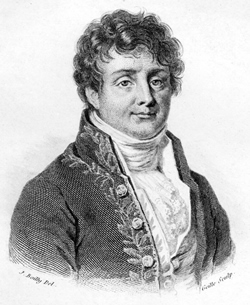 His interpretation of geological history was consistent with that of chemist Antoine-Laurent Lavoisier (1743-1794), who by 1789 had seen, in the alternating deep-water and shallow water deposits of the Paris Basin, evidence for a succession of slow marine transgressions and regressions. His vision of how these packages of sediment were built up through time by the alternating rising and falling of sea level is like our modern understanding of sedimentary cycles and far ahead of his time.
His interpretation of geological history was consistent with that of chemist Antoine-Laurent Lavoisier (1743-1794), who by 1789 had seen, in the alternating deep-water and shallow water deposits of the Paris Basin, evidence for a succession of slow marine transgressions and regressions. His vision of how these packages of sediment were built up through time by the alternating rising and falling of sea level is like our modern understanding of sedimentary cycles and far ahead of his time.
Early 1800s
Lavoisier’s report influenced Alexandre Brongniart (1770-1847), newly appointed Director of the porcelain factory at Sèvres, who was keen to find new deposits of clay near the capital. Visiting London in 1802 to find out more about the mass production of ceramics by the Wedgwood factory, he was made aware of the novel stratigraphic ideas of William Smith (1769-1839). Returning to France he persuaded Cuvier to work with him to apply Smith’s techniques to map the Paris Basin, delivering their results in 1808 and 1811.
German geologist, botanist and polymath Baron Alexander von Humboldt (1769-1859) - pictured left - made expeditions that convinced him that Nature was holistic – its parts were intimately related and only understandable with reference to the whole: plants grew where they did in response to relationships between biology, meteorology, geography and geology. His analysis of the global distribution of temperatures demonstrated in 1817 that they followed ‘isothermal lines’ dividing the world into climatic zones.
Lyell’s Principles
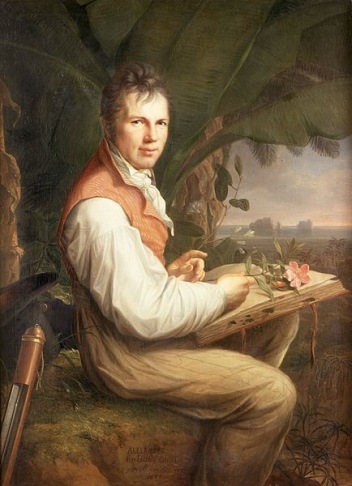 This set the scene for Charles Lyell (1797-1875), the greatest geologist of his time. A great integrator, Lyell rose to fame with the publication of his Principles of Geology in three volumes between 1830 and 1833, and (from 1838) his Elements of Geology, a guide to the practice of the new science. Together these were the first comprehensive geological textbook.
This set the scene for Charles Lyell (1797-1875), the greatest geologist of his time. A great integrator, Lyell rose to fame with the publication of his Principles of Geology in three volumes between 1830 and 1833, and (from 1838) his Elements of Geology, a guide to the practice of the new science. Together these were the first comprehensive geological textbook.
The key to Lyell’s approach lay in the subtitle to Principles, namely: “An attempt to explain the former changes of the Earth’s surface by causes now in operation”, which demonstrates the influence of Hutton (‘the present is the key to the past’). Unlike Cuvier, Lyell believed that what appeared from the geological record to be the results of catastrophic events arose instead by the steady action of processes observable today.
 1823, Lyell met Cuvier, along with Brongniart and Brongniart’s former student Constant Prévost (1787-1856), while visiting Paris to improve his French. He was impressed to find that young Prévost, unlike Cuvier (pictured, right), thought that the changes in strata in the Paris Basin came about gradually, not as the result of a series of catastrophic events.
1823, Lyell met Cuvier, along with Brongniart and Brongniart’s former student Constant Prévost (1787-1856), while visiting Paris to improve his French. He was impressed to find that young Prévost, unlike Cuvier (pictured, right), thought that the changes in strata in the Paris Basin came about gradually, not as the result of a series of catastrophic events.
A key influence on the Principles was Italian geologist Giovanni Battista Brocchi (1772-1826), curator of the museum of natural history in Milan. He in 1814 published a comprehensive study of the molluscan fossils and stratigraphy of Italy’s sub-Appenine region - a study comparable to that of William Smith in England and Brongniart and Cuvier around Paris. Comparing modern and ancient molluscs, Brocchi noticed that the recent species from older Tertiary strata now inhabit warmer climates, suggesting, as Lamarck had deduced, that the world was cooling.
Taking note, Lyell became expert on fossil molluscs. By 1828 he had used the changing percentages of modern molluscs to subdivide the Tertiary Period into several geological epochs. Enlarging his studies with the help of other fossil mollusc experts (Gérard Deshayes (1795-1875) in France and Henrick Beck (1799-1863) in Denmark) he concluded that Europe’s Eocene had had a ‘tropical’ climate, while Pliocene climate was more like today’s, with the Miocene lying in between. In volume two of the Principles he observed: “a great body of evidence, derived from independent sources, that the general temperature has been cooling down during the epochs which immediately preceded our own” - an observation later confirmed by palaeobotany.
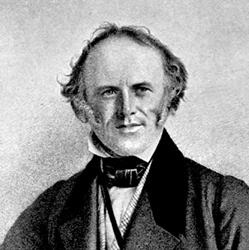 Lyell (pictured, left) devoted three chapters in Principles (volume 1) to showing how past climates could be recognised from types and distributions of sedimentary rocks and fossils. He also incorporated seven chapters on ‘Aqueous Causes’, under which he listed rivers, torrents, springs, currents, tides and icebergs as agents, all of them changing with climate. He agreed with Buffon, Cuvier, Lamarck and Brocchi that Europe’s climate had been much warmer in former times, but found no need to explain the cooling by catastrophe (Cuvier) nor by the cooling of the planet itself (Buffon).
Lyell (pictured, left) devoted three chapters in Principles (volume 1) to showing how past climates could be recognised from types and distributions of sedimentary rocks and fossils. He also incorporated seven chapters on ‘Aqueous Causes’, under which he listed rivers, torrents, springs, currents, tides and icebergs as agents, all of them changing with climate. He agreed with Buffon, Cuvier, Lamarck and Brocchi that Europe’s climate had been much warmer in former times, but found no need to explain the cooling by catastrophe (Cuvier) nor by the cooling of the planet itself (Buffon).
Lyell was much influenced by Humboldt, whom he met in Paris in 1823, and in Potsdam in1850, immediately realising the geological significance of his ‘isothermal lines’. If Europe’s older rocks had been deposited in much warmer climates than today’s, and if the Earth’s climate zones had not changed, then Europe must have moved across them. Geography had changed with time. Writing excitedly to Gideon Mantell (1790-1852) in February 1830, and swearing him to secrecy, he said: “I will give you a receipt [‘recipe’] for growing tree ferns at the pole, or if it suits me, pines at the equator; walruses under the line [the Equator], and crocodiles in the arctic circle.” [18]. This idea profoundly changed the way people thought about climate change.
Lyell’s thinking on geographical control of climate matured as he gathered more data – especially during visits to North America in the 1840s. In the 12th edition of the Principles, anticipating Alfred Wegener’s continental drift, he observed: “If we go back … to the Eocene period…we find such a mixture of forms now having their nearest living allies in the most distant parts of the globe, that we cannot doubt that the distribution of land and sea bore scarcely any resemblance to that now established.”
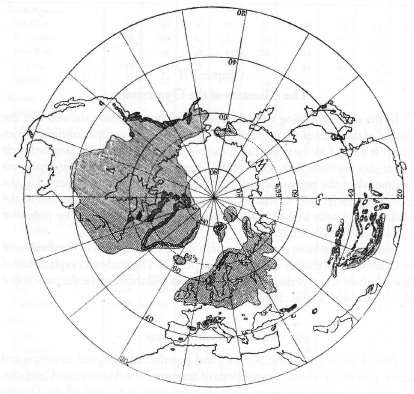 He was well aware of how geography (the positions of continents, coasts and topography) modified climatic zones, observing: “…on these geographical conditions the temperature of the atmosphere and of the ocean in any given region and at any given period must mainly depend…”. Moving continents around was dramatic stuff, though Lyell had no other information than his climate theory to back him up. The rest would have to await Wegener.
He was well aware of how geography (the positions of continents, coasts and topography) modified climatic zones, observing: “…on these geographical conditions the temperature of the atmosphere and of the ocean in any given region and at any given period must mainly depend…”. Moving continents around was dramatic stuff, though Lyell had no other information than his climate theory to back him up. The rest would have to await Wegener.
(Right - Koppen & Wegener's fig 24: Distribution of ice sheets in the Northern Hemisphere, as known at the end of the 19th Century).
Ice Age controversy
Lyell was also aware that ice could move and behave as a geological agent. Not only had he seen mountain glaciers transporting rock debris to be dumped in moraines, but also he knew that polar mariners had seen drifting icebergs transporting large amounts of rock. That led him to speculate that melting icebergs would dump their loads on the seabed to “…offer perplexing problems to future geologists”.
In Volume 3 of the first edition of Principles he speculated that the erratic blocks littering the landscape away from glacial valleys in the Alps and the Jura had been transported by floating ice (not by ice sliding over land as some Swiss geologists thought). At that time Lyell did not link the erratic blocks of Switzerland to those of northern Germany or Britain. However, his notion that erratic blocks of alien geology might have been deposited naturally by icebergs was a blow to the early 19th Century theory, embraced by - among others - Lyell’s old Oxford tutor, William Buckland (1784-1856: pictured, below), that such blocks were the relics of Noah’s flood.
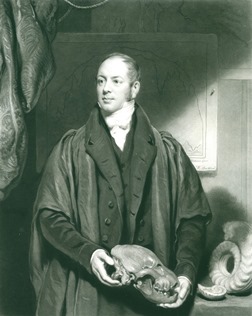 Before long Lyell’s iceberg hypothesis embroiled him in a climate controversy that was to last for most of the 45 years between the first and last publication of Principles. It began with the pronouncement, in 1837 by Swiss geologist Jean Louis Rodolphe Agassiz (1807-1873), that a vast ice sheet must have carried erratic blocks across Europe in a recent Ice Age.
Before long Lyell’s iceberg hypothesis embroiled him in a climate controversy that was to last for most of the 45 years between the first and last publication of Principles. It began with the pronouncement, in 1837 by Swiss geologist Jean Louis Rodolphe Agassiz (1807-1873), that a vast ice sheet must have carried erratic blocks across Europe in a recent Ice Age.
Although Lyell had recognised the great cooling through the Tertiary to the present, and that recent times had been cold enough to freeze mammoths whole, he had not realised that its most recent manifestation had frozen the northern regions. Nothing was known at that time of the geological history of the Antarctic. Agassiz had learned from Jean de Charpentier (1786-1855), Director of Mines of Switzerland’s Canton de Vaud, that Swiss glaciers had formerly been much more extensive. Knowing, in addition, that erratic blocks were common across northern Europe, Agassiz had made a giant intellectual leap, concluding that a great ice sheet had “covered the surface of the earth with a sheet of ice, extending at least from the north pole to Central Europe and Asia”. This drew much astonishment and ridicule, and Humboldt counselled Agassiz to abandon his icy speculations.
Very few Europeans knew anything about ice sheets. Little was known about Greenland, and the vast extent of the Antarctic ice sheet was not appreciated until after James Clark Ross (1800-1862) had published (in 1847) the results of his visits to the Ross Sea with HMS Erebus and HMS Terror in 1841 and 1842. Even so, Agassiz had leapt ahead of himself by claiming that ice extended as far as the Mediterranean, when, as we now know, glacial erratic blocks were actually confined to the Alps and northernmost Europe. Agassiz’s Ice Age hypothesis was fully developed in his 1840 book Etudes sur les Glaciers, and further expanded to include North America after his discovery of evidence for a former ice sheet there following a visit to Boston in 1846.
Buckland
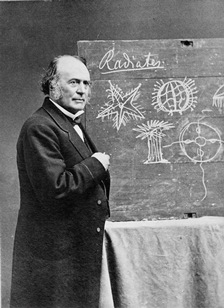 By 1840, Agassiz (right) had convinced William Buckland that there had indeed been an Ice Age in recent times and that northern Britain carried evidence of the passage of a vast ice sheet. Buckland even managed to convince Lyell that the piles of rocks near Lyell’s Scottish home were probably moraines. Nevertheless, their combined lectures to the Geological Society, in November and December 1840, failed to convince their audience, leading Buckland to concluded the session by condemning to “the pains of eternal itch without the privilege of scratching” anyone challenging ice age theory.
By 1840, Agassiz (right) had convinced William Buckland that there had indeed been an Ice Age in recent times and that northern Britain carried evidence of the passage of a vast ice sheet. Buckland even managed to convince Lyell that the piles of rocks near Lyell’s Scottish home were probably moraines. Nevertheless, their combined lectures to the Geological Society, in November and December 1840, failed to convince their audience, leading Buckland to concluded the session by condemning to “the pains of eternal itch without the privilege of scratching” anyone challenging ice age theory.
Part of the problem was that Roderick Murchison (1792-1871), who had visited Scotland with Agassiz and Buckland, remained unconvinced. Murchison had been President of the Geological Society of London from 1831-33, and was again from 1841-43. During his Presidential Address in the latter term, he attacked Ice Age theory, not recanting until 1862, in a further address. Sending a copy of this 1862 paper to Agassiz he wrote: “I have the sincerest pleasure in avowing that I was wrong in opposing as I did your grand and original idea of my native mountains. Yes! I am now convinced that glaciers did descend from the mountains to the plains as they do now in Greenland”. Evidence had mounted up, due in no small part to the assiduous research of Archibald Geikie (1835-1924), who was to publish a seminal paper on the glacial deposits of Scotland in 1863, and of which Murchison was aware.
Lyell remained unconvinced, certain that the gouges in Scottish rocks that Geikie attributed to stones embedded in an ice sheet were carved by stones embedded in icebergs. Having seen moraines in the Alps, he was not going to deny the role of mountain glaciers in transporting erratic blocks; but he thought that icebergs had done the work beyond the mountains, depositing what he called ‘glacial drift’, including boulder clay, or what he termed ‘till’. We unwittingly inherit this thinking in using the term ‘drift’ today. Lyell’s ‘drift’ replaced what had been termed ‘diluvium’, following Buckland’s idea that these were deposits from Noah’s flood. Terminology reflects history.
Lyell seems not to have realised that periodically covering the UK (and indeed adjacent Europe) with an iceberg-studded sea several hundreds of feet deep would require either rather sudden changes in sea level or, conversely, sudden changes in land level, for neither of which was there any evidence, nor indeed any plausible mechanism. One might consider these suppositions as infractions of his otherwise uniformitarian approach!
Vision
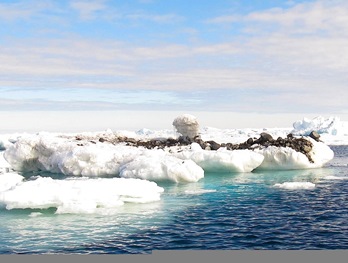 The contrast between Lyell and Agassiz was one of vision. Lyell stuck to hard evidence. He thought he knew what glaciers and icebergs could do, but his knowledge was limited. Agassiz could envision a merging of mountain glaciers into a great sheet of ice that he called “God’s Great Plough”, covering entire landscapes and dumping clay and boulders en route. While Lyell eventually accepted that smoothed and polished rocky surfaces in and around Switzerland and Scotland were formed by an ice sheet, he was adamant that it must have been local and that what lay beyond was due to icebergs broken from local ice sheets.
The contrast between Lyell and Agassiz was one of vision. Lyell stuck to hard evidence. He thought he knew what glaciers and icebergs could do, but his knowledge was limited. Agassiz could envision a merging of mountain glaciers into a great sheet of ice that he called “God’s Great Plough”, covering entire landscapes and dumping clay and boulders en route. While Lyell eventually accepted that smoothed and polished rocky surfaces in and around Switzerland and Scotland were formed by an ice sheet, he was adamant that it must have been local and that what lay beyond was due to icebergs broken from local ice sheets.
Picture: Ice transporting rocks at sea, Erebus & Terror Gulf, West Antarctica. Photo: Colin Summerhayes.
The final nails in the coffin of his iceberg theory came just as the 12th and final edition of Principles was going to press. In 1874 James Geikie (1839-1915), Archibald’s younger brother, published a definitive study of glacial geology - The Great Ice Age, clearly demonstrating the role of ice sheets - and in 1875 James Croll (1821-1890) reported that icebergs carrying stones – one of the pillars of Lyell’s theory - were exceedingly rare. (Even so, while bergs with stones on the surface may be rare, that does not mean that they do not have stones embedded in their largely invisible bases.)
Nowadays we know that Lyell was partly right. Ice Age iceberg drift does explain the occurrence of blocks of granite and related continental rocks dredged from the Mid-Atlantic Ridge in the northern North Atlantic, and the African continental shelf south of Cape Town. And as Bill Ruddiman showed in 1977, ice-rafted sediment dropped by icebergs derived from the Laurentide ice sheet covers much of the floor of the North Atlantic. On a Marion Dufresne cruise in 1995 I even found some of it in a core on the Portuguese margin off faraway Lisbon. In 1988 Hartmut Heinrich showed that these deposits were cyclic – we now call them Heinrich Events, each reflecting a surge in the Canadian ice sheet. Wedded as he was to icebergs, I am sure Lyell would have been excited to see that the science always moves on.
Reference
This feature is a distillation of Chapter 2 of Summerhayes, C P, 2015: ‘Earth’s Climate Evolution’ Wiley, Chichester. The references quoted in the text may be found in the Further reading list below.
* Dr Colin P Summerhayes BSc, MSc, DIC, PhD, DSc, CGeol, CMarSci is Emeritus Associate of the Scott Polar Research Institute, Cambridge. E: [email protected]
Further reading
-
Agassiz, E.C. (1885) Louis Agassiz, his Life and Correspondence. A Project Gutenberg e-book.
-
Agassiz, L. (1838) On the erratic blocks of the Jura. Edinburgh New. Phil. Journal 24, 176-179
-
Agassiz, L. (1840) Etudes sur les Glaciers, Jent and Gassman, Neuchâtel. Also see Agassiz, A. (1967) Studies on Glaciers. Preceded by the Discourse of Neuchatel, translated and edited by A. Carozzi. Hafner Publ. Co.
-
Agassiz, L. (1840) On the evidence of the former existence of glaciers in Scotland, Ireland and England, Proc. Geol. Soc. Lond. III, Part II, No. 72, pp 327-332; also Buckland, pp 332-337 and 345-348; and Lyell, pp 337-345 in the same issue. Lyell applied to the Society on 5 May 1841 to have his complete paper withdrawn, and Buckland did the same in June 1842.
-
Bard, E (2004) Greenhouse effect and ice ages: historical perspective, C.R. Geoscience 336, 603-638.
-
Bonney, T.G. (1895) Charles Lyell and Modern Geology, Macmillan and Co., New York. 222 pp. (Available on the Internet via Project Gutenberg).
-
Buffon, 1788, Époques de la Nature. Supplement to volume 5 of Histoire Naturelle, Générale et Particuliére, in 36 volumes, see www.buffon.cnrs.fr/ice.
-
Carozzi, A.V. (1965) Lavoisier’s fundamental contribution to stratigraphy. The Ohio Jour, Sci. 65 (2), 71-85.
-
Croll, J. (1875) Climate and Time in their Geological Relations: a Theory of Secular Changes of the Earth’s Climate, Appleton and Co, New York (www.archive.org).
-
Davies, G.H. (2007) Whatever Is Under The Earth, Geol. Soc. London, 356 pp
-
Geikie, A. (1863) On the phenomena of the glacial drift of Scotland, Trans. Geol. Soc. Glasgow I, Part II, available at http://digital.nls.uk/early-gaelic-book-collections/pageturner.cfm?id=77409534.
-
Geikie, J. (1874) The Great Ice Age, and its Relation to the Antiquity of Man, 3rd edition, Stanford, London, 1894. Available at www.archive.org.
-
Geikie, A. (1897) Founders of Geology, Macmillan, London, downloadable from www.archive.org.
-
Heinrich, H., 1988, Origin and consequences of cyclic ice-rafting in the northeast Atlantic Ocean during the past 130,000 years. Quat. Res. 29, 142-152.
-
Huggett, Q.J., and Kidd, R.B. (1983/84) Identification of ice-rafted and other exotic material in deep-sea dredge hauls. Geo-Marine Letts. 3, 23-29.
-
Humboldt, A. v. (1817) Von den isothermen linien und der verteilung der wärme auf dem erdkörper, Mémoires de Physique et de Chimie de la Société d’Arceuil 3, 462–602; reprinted in: Alexander von Humboldt, Studienausgabe, Sieben Bände, hrsg. von Hanno Beck, Band VI, 18–97 (Darmstadt: Wissenschaftliche Buchgesellschaft, 1989); (1820-21) English translation “On isothermal lines, and the distribution of heat over the globe”, in Edinburgh Philosophical Journal III (5), July 1820, 2-20, III (6), October, 256-274, IV (7), December, 1820, 23-37; IV (8), April 1821, 262-280, and V (9), July, 1821, 28-38.
-
Köppen, W., and Wegener, A., 1924, Die Klimate der geologischen Vorzeit. Borntrager, Germany
-
Lavoisier, A. (1789) Observations generates sur les couches horizontales, qui ont ete deposés par la mer, et sur les consequences qu'on peut tirer de leurs dispositions, relativement a l'anciénnete du globe terrestre. Mem. Acad. Roy. Sci. 351-371.
-
Lyell, K.M. (1881) Life, Letters and Journals of Sir Charles Lyell, Bart, Volumes 1 and 2, J. Murray, London, 475 pp and 489 pp.
-
McCrory, D. (2010) Natures Interpreter – The Life and Times of Alexander von Humboldt. Lutterworth Press, 242 pp;
-
Needham, H.D. (1962) Ice-rafted rocks from the Atlantic Ocean of the coast of the Cape of Good Hope. Deep Sea Res. 9 (11-12), 475-486.
-
Ruddiman, W.F., 1977, Late Quaternary deposition of ice-rafted sand in the subpolar North Atlantic (Lat. 40 to 65N). Bull. Geol. Soc. Am., 88, 1813-1827.
-
Rudwick, M.J.S. (2005) Bursting the Limits of Time: the Reconstruction of Geohistory in the Age of Reason. Univ. Chicago Press, Chicago, London, 708 pp
-
Rudwick, M.J.S. (1998) Lyell and the principles of geology, in Lyell: The Past is the Key to the Present (eds D.J. Blundell and A.C. Scott), Geol. Soc. Spec. Pub. 143, 3-15.
-
Thomson, J., Nixon, S., Summerhayes, C.P., Schönfeld, J., Zahn, R., and Grootes, P., 1999, Implications for sediment changes on the Iberian margin over the last two glacial/interglacial transitions from (230Th-excess) systematics. Earth Plan. Sci. Letts., 165, 255-270.
-
Vai, G.B. (2009) Light and shadow: the status of Italian Geology around 1807, in The Making of the Geological Society of London (eds C.L.E. Lewis and S.J. Knell), Geol. Soc. Spec Pub. 317, 179-202.
-
Wilson, L.G. (1972) Charles Lyell; the Years to 1841: The Revolution in Geology, Yale Univ. Press, New Haven and London, 553 pp.